Peetak Mitra
HAiVA: Hybrid AI-assisted Visual Analysis Framework to Study the Effects of Cloud Properties on Climate Patterns
May 13, 2023

Abstract:Clouds have a significant impact on the Earth's climate system. They play a vital role in modulating Earth's radiation budget and driving regional changes in temperature and precipitation. This makes clouds ideal for climate intervention techniques like Marine Cloud Brightening (MCB) which refers to modification in cloud reflectivity, thereby cooling the surrounding region. However, to avoid unintended effects of MCB, we need a better understanding of the complex cloud to climate response function. Designing and testing such interventions scenarios with conventional Earth System Models is computationally expensive. Therefore, we propose a hybrid AI-assisted visual analysis framework to drive such scientific studies and facilitate interactive what-if investigation of different MCB intervention scenarios to assess their intended and unintended impacts on climate patterns. We work with a team of climate scientists to develop a suite of hybrid AI models emulating cloud-climate response function and design a tightly coupled frontend interactive visual analysis system to perform different MCB intervention experiments.
Improving CFD simulations by local machine-learned correction
Apr 28, 2023Abstract:High-fidelity computational fluid dynamics (CFD) simulations for design space explorations can be exceedingly expensive due to the cost associated with resolving the finer scales. This computational cost/accuracy trade-off is a major challenge for modern CFD simulations. In the present study, we propose a method that uses a trained machine learning model that has learned to predict the discretization error as a function of largescale flow features to inversely estimate the degree of lost information due to mesh coarsening. This information is then added back to the low-resolution solution during runtime, thereby enhancing the quality of the under-resolved coarse mesh simulation. The use of a coarser mesh produces a non-linear benefit in speed while the cost of inferring and correcting for the lost information has a linear cost. We demonstrate the numerical stability of a problem of engineering interest, a 3D turbulent channel flow. In addition to this demonstration, we further show the potential for speedup without sacrificing solution accuracy using this method, thereby making the cost/accuracy trade-off of CFD more favorable.
Climate Intervention Analysis using AI Model Guided by Statistical Physics Principles
Feb 07, 2023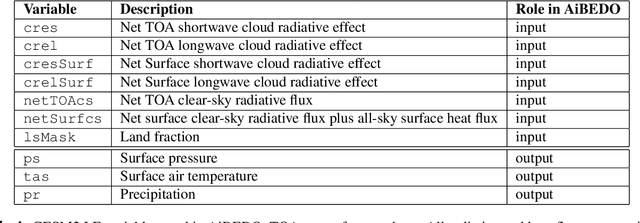
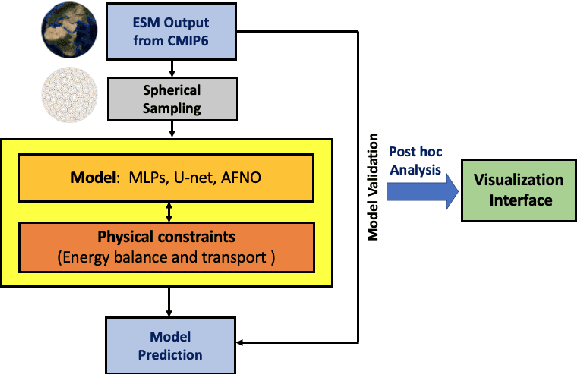
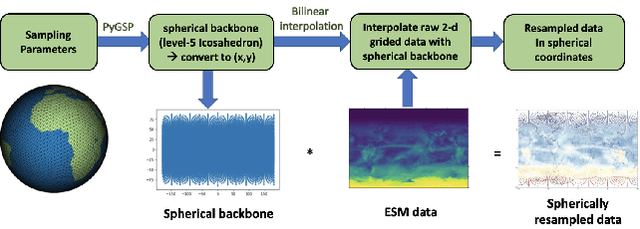

Abstract:The availability of training data remains a significant obstacle for the implementation of machine learning in scientific applications. In particular, estimating how a system might respond to external forcings or perturbations requires specialized labeled data or targeted simulations, which may be computationally intensive to generate at scale. In this study, we propose a novel solution to this challenge by utilizing a principle from statistical physics known as the Fluctuation-Dissipation Theorem (FDT) to discover knowledge using an AI model that can rapidly produce scenarios for different external forcings. By leveraging FDT, we are able to extract information encoded in a large dataset produced by Earth System Models, which includes 8250 years of internal climate fluctuations, to estimate the climate system's response to forcings. Our model, AiBEDO, is capable of capturing the complex, multi-timescale effects of radiation perturbations on global and regional surface climate, allowing for a substantial acceleration of the exploration of the impacts of spatially-heterogenous climate forcers. To demonstrate the utility of AiBEDO, we use the example of a climate intervention technique called Marine Cloud Brightening, with the ultimate goal of optimizing the spatial pattern of cloud brightening to achieve regional climate targets and prevent known climate tipping points. While we showcase the effectiveness of our approach in the context of climate science, it is generally applicable to other scientific disciplines that are limited by the extensive computational demands of domain simulation models. Source code of AiBEDO framework is made available at https://github.com/kramea/kdd_aibedo. A sample dataset is made available at https://doi.org/10.5281/zenodo.7597027. Additional data available upon request.
Accelerating exploration of Marine Cloud Brightening impacts on tipping points Using an AI Implementation of Fluctuation-Dissipation Theorem
Feb 03, 2023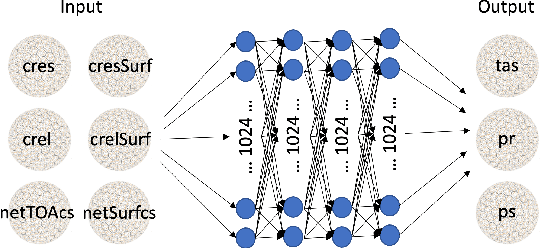


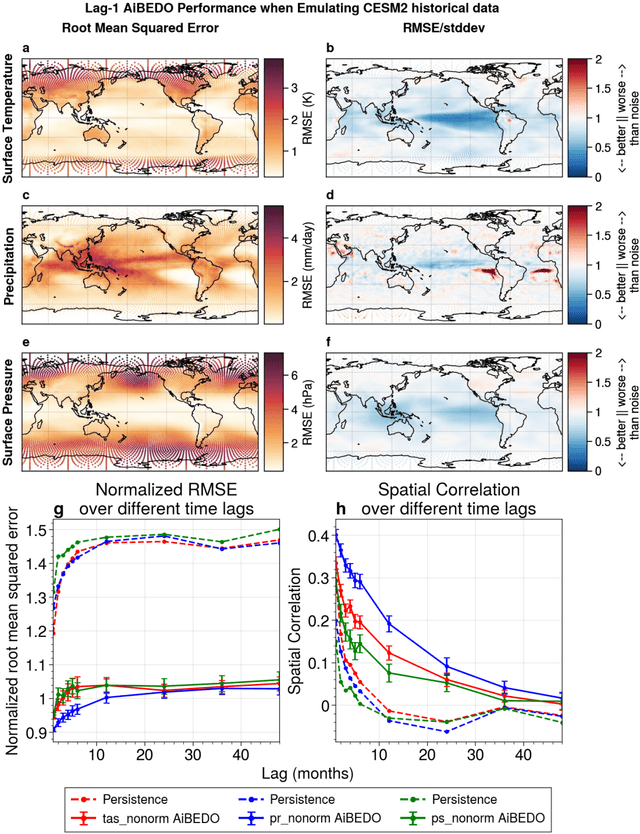
Abstract:Marine cloud brightening (MCB) is a proposed climate intervention technology to partially offset greenhouse gas warming and possibly avoid crossing climate tipping points. The impacts of MCB on regional climate are typically estimated using computationally expensive Earth System Model (ESM) simulations, preventing a thorough assessment of the large possibility space of potential MCB interventions. Here, we describe an AI model, named AiBEDO, that can be used to rapidly projects climate responses to forcings via a novel application of the Fluctuation-Dissipation Theorem (FDT). AiBEDO is a Multilayer Perceptron (MLP) model that uses maps monthly-mean radiation anomalies to surface climate anomalies at a range of time lags. By leveraging a large existing dataset of ESM simulations containing internal climate noise, we use AiBEDO to construct an FDT operator that successfully projects climate responses to MCB forcing, when evaluated against ESM simulations. We propose that AiBEDO-FDT can be used to optimize MCB forcing patterns to reduce tipping point risks while minimizing negative side effects in other parts of the climate.
Proceedings of AAAI 2022 Fall Symposium: The Role of AI in Responding to Climate Challenges
Jan 06, 2023Abstract:Climate change is one of the most pressing challenges of our time, requiring rapid action across society. As artificial intelligence tools (AI) are rapidly deployed, it is therefore crucial to understand how they will impact climate action. On the one hand, AI can support applications in climate change mitigation (reducing or preventing greenhouse gas emissions), adaptation (preparing for the effects of a changing climate), and climate science. These applications have implications in areas ranging as widely as energy, agriculture, and finance. At the same time, AI is used in many ways that hinder climate action (e.g., by accelerating the use of greenhouse gas-emitting fossil fuels). In addition, AI technologies have a carbon and energy footprint themselves. This symposium brought together participants from across academia, industry, government, and civil society to explore these intersections of AI with climate change, as well as how each of these sectors can contribute to solutions.
Deep Learning Framework for Pedestrian Collision Avoidance System (PeCAS)
Nov 11, 2018



Abstract:Drowsy driving is a major cause of on-road accidents in the US, which sometimes is fatal to unsuspecting pedestrians. This framework based on Deep Learning proposes an approach to detect the onset of drowsiness in a vehicle operator especially alerting the driver when in the proximity of a pedestrian. Using Convolutional Neural Network (CNN), an approach is proposed to detect drowsiness based on the Viola-Jones algorithm. The pedestrian detector is also based on a deep CNN architecture and is capable to detect multiple pedestrians. In the end, an integration of the output from the two architectures is fed into an Arduino hardware kit to generate warnings for the vehicle operator.
 Add to Chrome
Add to Chrome Add to Firefox
Add to Firefox Add to Edge
Add to Edge